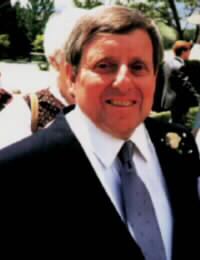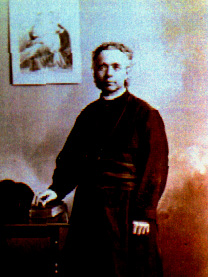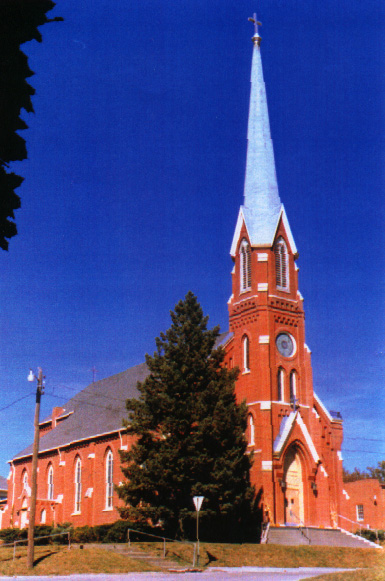

Who was Father Theo Schiffmacher ?
Submitted for publication in Boulder Genealogical Society Quarterly
By Edward.R.Schiffmacher
E-Mail Address: " eschiffm@ix.netcom.com "
In January 1991, some time after I had searched the 1900 Federal Census and extracted information from all the Schiffmacher listings, I composed a query letter to circulate in the hope of contacting someone else researching my family name.

There were only 53 Schiffmacher individuals listed, and about half of them I immediately identified as known relatives.
In my queryletter, I summarized what I knew about my own family line, listed the data about the other families, and asked for any further information which might be available.
The query letter went out to a mailing list of about 30 Schiffmachers whose addresses I found by searching telephone books in the University of Colorado library.
At that time I had already learned of ongoing Schiffmacher family research in both Germany and the Netherlands.
Siegfried Schiffmacher of Vancouver, B.C., whose address I had copied from the phone book during a trip to Vancouver, had referred me to his brother Rudi in Germany, and Rudi in turn had told me about Hendrikus Schiffmacher in Harderwijk, Netherlands.
A friend of Hendrikus, J. E. Strijd, had been researching the Schiffmacher genealogy for many years, and my correspondence with Hendrikus was shared with him as well.
Rudi in Germany and Hendrikus and Mr. Strijd in the Netherlands all kindly shared the results of their research with me.
From them I learned that my family name had apparently originated in Alsace or nearby in Germany.
Rudi's family had come from Seltz, Alsace, and Hendrikus' line had been traced back to the nearby Town of Scheibenhard, also in Alsace.
However, neither of them had any record of my immigrant ancestor,
great grandfather Joseph Louis Anthony Schiffmacher, who according to family records had been born in Seltz.
I in turn had shared the information which I had about my own family line with both of them.
The responses to my query letter during 1991 resulted in
identifying many of the unknowns from the 1900 census into two other immigrant lines, neither of which appeared to have roots in Alsace.
There was also some new information about my own line.
I shared these results with my European correspondents, and this provided them with additional clues which they pursued.
It was not long before my immigrant ancestor was definitely identified as being in the same family line as Rudi in Germany, through birth and baptism records from archives in Strassbourg.
One of the 1990 Federal Census entries was that of M. J. Schiffmacher, in Neola Township, Iowa.


He was born in France in1834, he was single and his occupation was: Minister.
His parents were both born in France, and he had come to America in 1866.
None of the query responses had noted any knowledge of him.
In an attempt to find more about M. J., I explained my interests in a letter to the Mayor of Neola (by now a city), asking him to circulate my inquiry to the Neola churches which had been active in 1900.
A reply came quickly from the secretary of Saint Patrick's Catholic Church, enclosing copies of several pages from the church's Centennial Book, published in 1982, which mentioned the name, M. T. Schiffmacher.

I had mis-read the middle initial from the census film.
One of those pages included his obituary; he had been born in Alsace-Lorraine, and had died in Neola on January 24, 1901.
However, his full given name was never mentioned; only the initials.
A month later, we visited Neola during a trip East, and met with Sister Roberta Brich, who was in charge of Saint Joseph's School adjacent to Saint Patrick's.
She was well aware of the importance of Father Schiffmacher in the early years of Saint Patrick's, and gave me a copy of the Centennial Book.
She also took us to meet her mother, who lived close to the church.
Mrs. Brich remembered her parents' saying that Father. Schiffmacher had "ruled the Parish with an iron hand!".
On her mantle was a framed photograph of Father Schiffmacher, apparently dating from not long after his
ordination in 1860.
She presented me with this photograph, feeling that, since I was very likely a relative of Father Schiffmacher, it was appropriate that I should have it.
She directed us to the cemetery on the hill above Neola, where Father Schiffmacher was buried.


We found his grave and photographed his impressive tombstone, which included his ordination date as well as birth and death dates.
Later when we studied the Centennial Book, we discovered only a single mention of his full name, Father Mary Theodore Schiffmacher.
His obituary told us the following:

"... M. T. Schiffmacher was born in Alasce-Lorainne (sic),
now a part of the German empire, but at the time belonging
to France, in August 1834.
He came from a noted family, one well known in French history,
his father, being a prominent French General.
He was educated in Paris, and after finishing his education,
he was sent by the Catholic Church to Dublin, Ireland,
where he founded Black Rock College.
From there he came to this country and was assigned to
what was then the Diocese of Dubuque.
His first station was at Washington, Iowa,
where he remained until 1868.
He was then sent to Bellevue, where he remained fourteen years...
From there he went to Red Oak and then to Fairfield.
From the latter place he came to Neola in 1886 where he since remained. ..."
Also from the Centennial Book we learned that by 1888, the parish of Neola had grown until the church was entirely too small for the congregation. ... "consequently, on February 23, 1888, Father Schiffmacher acquired the property to build a new and larger church -- the church which today is the pride of the parish.


It is a brick church with a seating capacity of about 600.
Towering over it is a high steeple which can be seen for miles.
It is one of the largest country churches in the Diocese of Des Moines.
It is a monument to the memory of Father Schiffmacher." ...
The famous "Orphan Trains" brought children from New York to Iowa.
The Centennial Book relates that...
"In Neola's St. Patrick's Parish, the children were
taken to the convent from the train depot.

The following Sunday they were taken to Mass by the Sisters.
After Mass, Father M. T. Schiffmacher would line up the
children in front of the Communion rail.
He would select a child for a family, and the parents were responsible
for making the child a welcomed and loved member of the family"...
By this time, I had gone on-line with my computer, and was able to search library catalogs using the CARL System.
I searched libraries in the U. S. in vain for any books or references to Black
Rock college in Dublin, which had been mentioned in the obituary of Father Schiffmacher.
However, I finally succeeded in accessing the catalog of the library of Oxford University in London, and found a single book about Blackrock College, "Pere Leman (1826-1880): educator and missionary: founder of Blackrock College"/ Sean P.
Farragher.
Dublin: Paraclete Press, 1988.
Unfortunately, it was not possible to arrange an interlibrary loan!
My computer also had brought me e-mail capability, so I sought a mailing address for Blackrock College from University College Dublin, for which I had found an e-mail address.
A UCD student kindly answered, and provided the necessary information.
I explained my interest in Father Schiffmacher in a letter which I addressed to "Office of the President, Blackrock College, County Dublin, Ireland".
To my great surprise, the answer came from the author of the book, Father Sean Farragher.
He said,
"... When I saw the name Schiffmacher on the envelope
I could scarce believe my eyes as I thought no one in the
world had met the name apart from myself..."
When he received my letter, Father Farragher had written to the central archives of his holy order, the Congregation of the Holy Spirit, in France.
The archivist had sent him copies of two documents: the birth record of Theodore Schiffmacher, and the marriage record of his parents!
My daughter and I struggled for some time with these records but we were simply unable to read them!
Of course, I had shared these records with Rudi, Hendrikus, and Mr. Strijd.
They also had difficulty with them, but in the Netherlands, Mr. Strijd eventually found a priest who was able to read them and understand and translate the "Church Latin" into Dutch.
Mr. Strijd then provided me with the translation from Dutch to English.
Those documents clearly identified Theodore's parents as belonging to the Seltzer Schiffmacher line, with his father being an uncle of my immigrant ancestor Joseph !
So my relationship to Father Schiffmacher was that of first cousin three times removed.
Father Farragher had also lamented that he had sought for years in
vain for a photograph of Father Schiffmacher.
I was very pleased to be able to send him a copy of the photo I'd received from Mrs.
Brich in Neola.
In subsequent correspondence with Father Farragher, he explained how Father Schiffmacher had come to Blackrock College at its opening in 1860 as a Holy Ghost Father, and that he had supervised the erection of the first of the buildings.
However, he remained there for only about two years.
" He built the first addition to Blackrock College in 1861"...... but
"He was a very sensitive and excitable man ......
In fact the reason he had to leave Blackrock at Xmas 1862
was that he 'clocked' - struck - another priest -
a German who was continually teasing him (Fr. Hobauer);
and it happened in front of the boys.
It was felt drastic action had to be taken!
He parted with our Society in France the following year...".
In 1868, after he had become a missionary priest and had been in Iowa for about two years, he wrote to Father Leman at Blackrock, hoping that he might return to the Congregation of the Holy Spirit. In that letter, he wrote "
..... It is beyond doubt that the secular priest
has great merits but in our wild prairies.....
(among our protestants, methodists, mormons, unbelieving free-masons, etc.,
etc.)
and a life of continual touring - having no fellow brother or two
and the bell which noticed you for duty, you become cold, disorderly, irreligious.
I hope the good God will forgive me recommend me in the prayers of the brotherhood
and I hope again to work for the glory of the good God from the floor of the Congregation ... "
( Translated from the French by Mr. Strijd).
But his plea to return was refused.
He remained in Iowa, assuming the post of Pastor at Neola in 1886.
There he stayed until hisdeath in 1901.
As a postscript to that article: I shared it with the nun (Sister Roberta Brich) from Neola who is mentioned in the article.
She just recently wrote me that Father S. had been very helpful to the Sisters of Humility (her order).
From her letter: "What I did not know at the time I spoke with you is that Father was very good to the Sisters of Humility.
He actually gave us the land on which we built our Motherhouse in Ottumwa, Iowa. ...
We have now sold the property in Ottumwa and moved to Davenport, Iowa. We have a small building for our Center.
The land and buildings in Ottumwa was sold to a Community College
who is making good use of it. ... "



![]()
![]()
